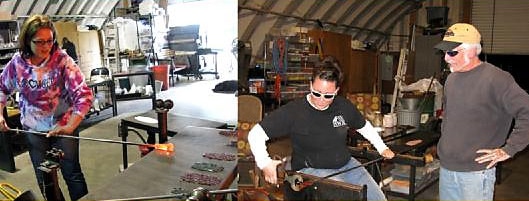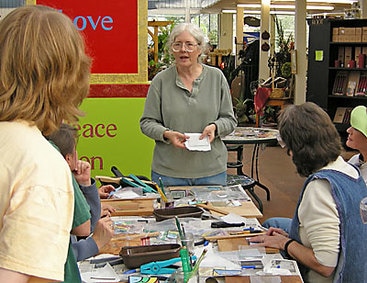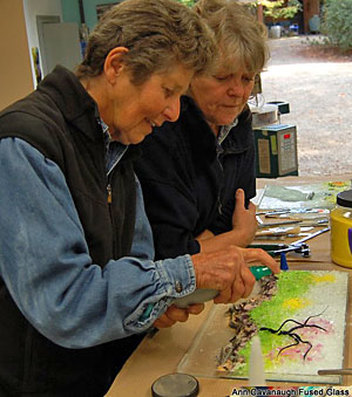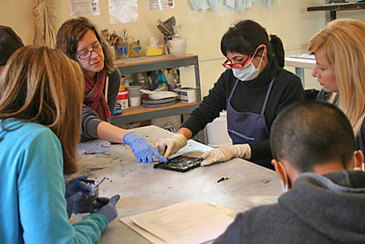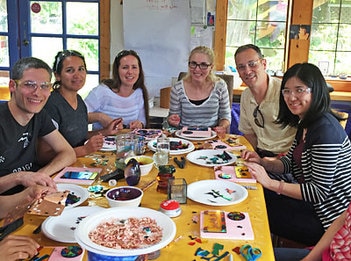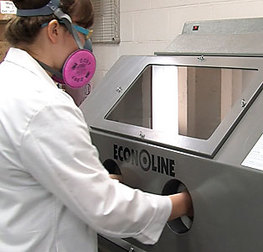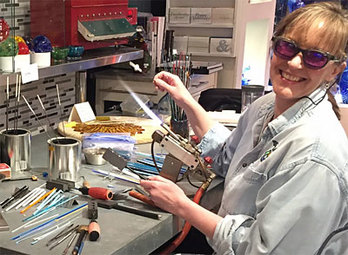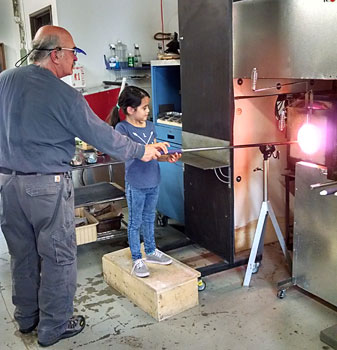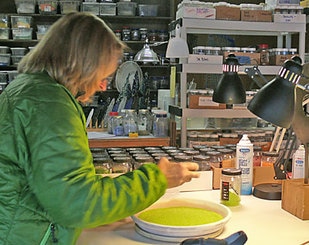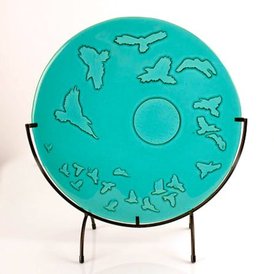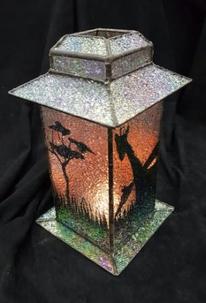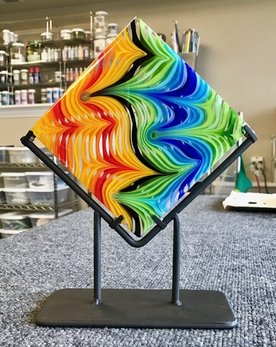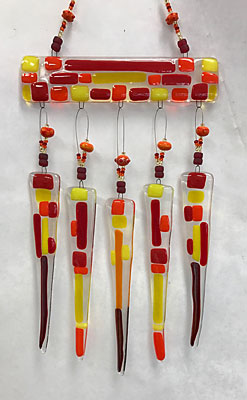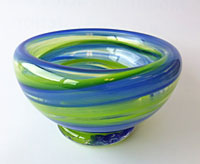Newsletter: spring 2017
|
Grow Glass
Increase your collection, your skills, and your knowledge by taking (or giving) a class.
|
Why?
Even if you just want to sit back and admire the work of others or if you think you aren't creative, having first-hand understanding of the process will increase your appreciation of the full range of finished glasswork. You might even discover a new creative outlet or a technique that applies to your own work in a very different medium. Get the basics. I challenge you to do each of these at least once, especially if you are happily settled in one form of glasswork:
Ask glass artists who they recommend or look at our class list. If you want more after you have mastered the basics, look for an artist who uses a technique you want to learn and ask if they teach. If you want a short, efficient introduction you probably want someone who has already taught the class a couple of times. On the other hand, exploring a new technique with someone only a few steps ahead of you can be an interesting interactive journey of great value for both of you. Mark Ellinger watches as a student marvers a piece. He'll be giving demonstrations at his studio, Glass Quest, during the Camano Island Studio Tour (WA) May 12-14 &20-21
|
Karen Seymour's students learn to cut curves for glass-on-glass appliqué at a local plant nursery (talk with Karen and several other glass artists on the Art In Bloom Seattle garden art & studio tour April 29-30)
Ann Cavanaugh watches a student make an image with frit (Ann and many other fine artists from the Oregon Glass Guild will be showing their work at the April 21-23 Gathering of the Guilds, in Portland OR)
|
|
Going further
A Seattle Mosaic Arts member gets tips on grouting. Joining a membership program is a good way to deal with a lack of space to be messy at home.
|
Marcia Wiley's students ready to learn fusing
Sandblasting at the Bullseye Resource Center in Portland. For a fee you can access the full cold-working shop at certain times once you've had instruction in the use of the equipment.
In addition to giving classes Art By Fire in Issaquah, WA rents both torch time and glass blowing time (photo by Amanda Fischer of Art by Fire Glass)
|
|
Teach: Students widen your vision. You often learn as much from your students as they do from you and your work gets even better. If you have qualms about creating more competition by teaching consider teaching what you have done instead of what you are currently working on. Personally I find my students are my best customers: once they understand what is involved in my process they understand what a bargain my finished pieces are. Many teachers I spoke with agreed. How to get started teaching:
Karen Seymour, Editor
|
Charlene Fort's students make fused holiday ornaments at the Dalles Art Center
Chris Heilman instructs a beginning glass blower at Renton Art & Glass studio. Chris also enjoys the challenge of teaching glass blowing to people with special needs if you know someone who would appreciate that extra attention and flexibility.
Steph Mader's student prepares a piece for the kiln in an erosion glass class at Steph's studio on Whidbey Island.
To help you to realize the wide range of possibilities we've tried to show instructors in many places and situations beyond the well known (and rightly so) Pilchuck Glass School in Stanwood WA, Schack Art Center in Everett WA, Pratt Fine Art Center in Seattle WA, and Bullseye Glass in Portland OR. Be sure to look at their classes too. |
What's New?
In keeping with the theme of this issue, these are examples of project photos for upcoming classes rather than really new work.
Take a class and make your own, send us a photo.
Take a class and make your own, send us a photo.
|
How'd They Do That?
|
|
Lori Soderberg's finished combing
|
(Yes, the kiln reads 1629) Thanks JLS Glass Studio! We all like to look at how others work. Please share your own how-to photo/video essays in this spot for the enlightenment of the community and a bit of free publicity (we're well over 100 subscribers now).
Announcements & Events
You will find local glass artists at:
The next newsletter, "The Glass Tourist", and a travel related coupon will be mailed in June. Where would you send people to explore glass beyond the Tacoma Museum of Glass, Shack Art Center's hot shop visitor window, and the Chihuly Garden and Glass Museum?
Post your comments, new work etc. to our moderated Facebook page
or email them to us
- April 21-23 Gathering of the Guilds, (including the Oregon Glass Guild) Portland OR
- April 29-30 Art In Bloom Seattle's Garden Art & Studio Tour (WA)
- May 12-14 & 20-21 Camano Island Studio Tour (WA)
- June 9-11 Sorticulture, Everett WA
- June 16-18 Edmonds Art Festival (WA)
- June 22-24 BeCon (the Bullseye Conference) in Portland June 22-24. Registration prices go up April 1st
The next newsletter, "The Glass Tourist", and a travel related coupon will be mailed in June. Where would you send people to explore glass beyond the Tacoma Museum of Glass, Shack Art Center's hot shop visitor window, and the Chihuly Garden and Glass Museum?
Post your comments, new work etc. to our moderated Facebook page
or email them to us
|
Friends In Glass Spring 2017 Coupon:
Grow Glass Expires April 30th, 2017 10% off of a regularly scheduled class paid for (but not necessarily taken) during April * from any of these participating organizations/instructors:
|
Subscribe to get a valid coupon of your own
*The fine print: Class must be paid for but not necessarily taken by April 30th. If there is a separate supply fee it is usually not included in the discount. Coupon can be used only once with any given organization/instructor. One size can’t possibly fit all: due to contracts, special agreements etc. the participating organization/instructor reserves the right to exempt any particular class from the coupon. Please enquire before attempting to redeem the coupon. Coupon is not transferable, can not be combined with any other discount and has no monetary value.
Copyright Friends In Glass 2017 -- All Images are used by permission and those copyrights are retained by the artists
